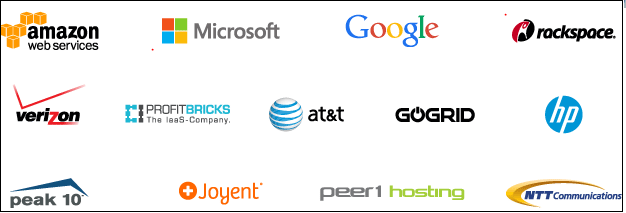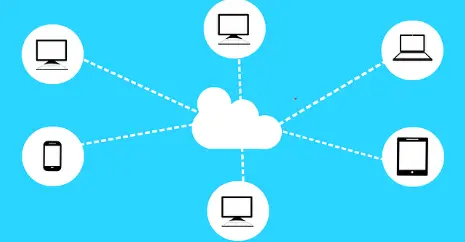Introduction to Cloud Computing
Cloud computing is a type of Internet-based computing that provides shared computer processing resources and data to computers and other devices on demand.
It is a model for providing on-demand access to a shared pool of configurable computing resources (Example computer networks, servers, storage, applications, and services) which can be rapidly provisioned and released with minimal management effort
Cloud computing is a new technology that delivers many types of resources over the Internet. Cloud computing can be identified as a technology that uses the Internet to deliver its services
Cloud computing, often referred to as simply “the cloud,” is the delivery of on-demand computing resources—everything from applications to data centers—over the internet on a pay-for-use basis
What are the technologies used in Cloud Computing
The main enabling technology for cloud computing are given below
1) Virtualization: It is one of the main technology enablers for Cloud computing. Virtualization software enables a physical computing device into multiple “virtual” devices, each of which can be easily used and managed to perform computing tasks. With operating-system-level virtualization essentially creating a scalable system of multiple independent computing devices, idle computing resources can be allocated and used more efficiently. Virtualization enables us to speed up IT operations and reduces costs by increasing infrastructure utilization. The entire process can be automated through which the user can provision resources on-demand. By minimizing user involvement, automation speeds up the process, reduces labor costs, and reduces the possibility of human errors.
2) Service-oriented Architecture (SOA): Cloud computing adopts concepts from Service-oriented Architecture (SOA). Cloud computing provides all of its resources as services and makes use of the well-established standards and best practices gained in the domain of SOA to allow global and easy access to cloud services in a standardized way.
Benefits of Cloud Computing
Cloud Computing aims to cut costs and helps the users focus on their core business instead of being impeded by IT Infrastructure obstacles.
Self-service provisioning: End users can create compute resources for almost any type of workload on-demand. They can also destroy the resource at their convenience. This eliminates the traditional need for IT administrators to provision and manage compute resources.
Elasticity: Companies can scale up as computing needs increase and scale down again as demands decrease. This helps them eliminate the need for massive investments in local infrastructure which may or may not remain active.
Pay per use: Compute resources are measured at a granular level, allowing users to pay only for the resources and workloads they use.
Essential characteristics of Cloud Computing:
The National Institute of Standards and Technology’s definition of cloud computing identifies “five essential characteristics”:
On-demand self-service. A consumer can unilaterally provision computing capabilities, such as server time and network storage, as needed automatically without requiring human interaction with each service provider.
Broad network access. Capabilities are available over the network and accessed through standard mechanisms that promote use by heterogeneous thin or thick client platforms (e.g., mobile phones, tablets, laptops, and workstations).
Resource pooling. The provider’s computing resources are pooled to serve multiple consumers using a multi-tenant model, with different physical and virtual resources dynamically assigned and reassigned according to consumer demand.
Rapid elasticity. Capabilities can be elastically provisioned and released, in some cases automatically, to scale rapidly outward and inward commensurate with demand. To the consumer, the capabilities available for provisioning often appear unlimited and can be appropriated in any quantity at any time.
Measured service. Cloud systems automatically control and optimize resource use by leveraging a metering capability at some level of abstraction appropriate to the type of service (e.g., storage, processing, bandwidth, and active user accounts). Resource usage can be monitored, controlled, and reported, providing transparency for both the provider and consumer of the utilized service
Cloud Computing Service Model
There are three service models as defined by the National Institute of Standards and Technology
1) IAAS: This is known as Infrastructure as a Service. Here the cloud provider gives the Physical infrastructure (network, storage, Computing power. Virtual machines) as a service that can be accessed over the internet. You can use that to install your software, application deployment, etc. The consumer does not manage or control the underlying cloud infrastructure but has control over operating systems, storage, and deployed applications; and possibly limited control of select networking components
2) PAAS: This is known as Platform as a Service. Here cloud providers deliver a computing platform, typically including operating system, programming-language execution environment, database, and the webserver. Application developers can develop and run their software solutions on a cloud platform without the cost and complexity of buying and managing the underlying hardware and software layers. The consumer does not manage or control the underlying cloud infrastructure including network, servers, operating systems, or storage, but has control over the deployed applications and possibly configuration settings for the application-hosting environment
3) SAAS: This is known as Software as a Service. Here cloud providers install and operate application software in the cloud and cloud users access the software from cloud clients. SaaS is sometimes referred to as “on-demand software” and is usually priced on a pay-per-use basis or using a subscription fee. Cloud users do not manage the cloud infrastructure and platform where the application runs. cloud Provider manage the infrastructure and platform both
Cloud Computing Deployment Model
Public Cloud:
It is basically the shared physical infrastructure on the third-party site. Many companies are sharing the same infrastructure
- It is quite easy for incremental or short term capacity
- Low investment – pay for use
- ideal for small and medium sized businesses or businesses that have changing demands
- Security of data is the major risk and not much control
Private Cloud
It is basically the dedicated physical infrastructure on the third-party site or on prim.Your company is only using the infrastructure
- Data is secure and total control on that server
- Initial High investment is the disadvantage
- ideal for business critical applications
Hybrid Cloud
It is a mix of public and private clouds. So it connects the public cloud infrastructure to the private cloud infrastructure. You can have Test/DEV instances on the Public Cloud and Production on On-prim private cloud
Popular Examples of Cloud Computing
- email like Gmail ,Hotmail etc
- Public storage like Microsoft One-drive, Google Drive
- Collaborations tools like Webex
Cloud Vendors
- Amazon Web Services
- Microsoft Azure
- HP cloud services
- Oracle clouds
- Google Cloud Platform
- Rackspace cloud services

Related Articles
Linux Operating System and Distribution : Article about Linux Operation system, Kernel, Various distribution available in Market.Learn about Oracle Enterprise Linux
oracle cloud infrastructure : Oracle Infrastructure as a Service is called Oracle Cloud Infrastructure (OCI). It offers storage, compute, database, networking, edge services
iaas paas saas : Learn the difference between IaaS stands for Infrastructure as service, PaaS stands for Platforms as a service and SaaS stands software as a service
oracle iaas: overview about various Oracle Cloud: Infrastructure-as-a-Service like Compute, storage, network services with various options
Virtualization : Virtualization is the process of creating multiple virtual machines /operating system from one physical hardware box with the help of a hypervisor
Recommended Courses
Cloud Computing Concepts : it Covers Fundamentals of Cloud Computing and types of cloud-like private, public, hybrid, IAAS, SAAS, PAAS, and cloud platforms like AWS, Azure, and Google Cloud. One of must-have course for anybody starting with Cloud
Introduction to Cloud Computing on Amazon AWS for Beginners : Learn about Amazon Web services.Various offerings are available with it like EC2, EBS ,S3. A good course for anybody starting with AWS
Google Cloud Platform (GCP) Fundamentals for Beginners : Learn how to use GCP compute, storage, and networking services, Key services of Google Cloud Platform.A good course for anybody starting with GCP
Introduction to Cloud Security with Microsoft Azure : It covers Azure services, Azure PowerShell. A good course for anybody starting with Microsoft Azure
